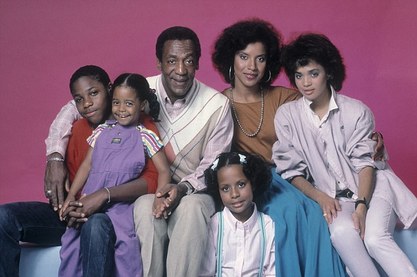 A scene from Jane the Virgin, a show with a Latina in the lead role.
A scene from Jane the Virgin, a show with a Latina in the lead role. The landscape of television has changed greatly since its emergence in the 1940s. One of the biggest changes in the medium is the amount of diversity we see on TV today. Although many believe that television still lacks stories revolving around people of color, the shows currently featuring minorities are funny, poignant, and extremely well done. From ABC’s Fresh off the Boat and Black-ish, to the CW’s Jane the Virgin, people of color are represented on TV more than ever. In particular, the evolution of the black sitcom has gone through several variations over the last couple of decades, each one setting the precedent for the next.
| | The first black sitcom to ever grace American television's was Amos ‘n’ Andy. First aired in 1951, the show was quickly denounced by the NAACP due to its origin as a minstrel radio show hosted by two white men. However, it did give black people a chance to be represented on television and was extremely popular. It was cancelled two years later, but kept in syndication for over ten years. |

Throughout the 50s and 60s, there were very few programs that featured black actors alongside white actors, let alone shows with all black casts. This changed come the early 70s. Television writer and producer Norman Lear released a variety of groundbreaking shows that reflected the political tensions of the time. His most notable success is All in the Family, a show chronicling a white working class family in New York. Specifically, the character Archie Bunker made a huge impact on American culture. A bigoted Republican, he represented a large section of the nation that did not know how to handle the country’s growing liberal ideas. Archie’s bigotry was often shown in his interactions with his successful black neighbor, George Jefferson.
Following the success of All in the Family, Lear went on the create Sanford and Son (1972). Sanford and Son is about a black father and son living in Watts, Los Angeles, California. Like Archie Bunker and his family, Fred and Lamont Sanford were working class. Sanford and Son offered an alternative to All in the Family, with the same biting commentary on race and class in America. Fred Sanford, the father of Lamont, was often suspicious of white people and their motives, similar to how Archie Bunker was untrustworthy of any minority.
After Sanford and Son’s smash success, Lear created Good Times (1974). The show was set in a poor black housing project located in Chicago. This show, along with Lear’s other programs, dominated the Nielsen ratings. The 70s was a time where television sitcoms became relatable to the viewer. Writers were not afraid to tackle taboo topics in such as abortion, teen pregnancy, and race relations on primetime television. Additionally, after the strides made by Black America with the Civil Rights Movement, it was clear that black people deserved and platform in television.
However, some wondered why black people were only being portrayed as poor and struggling. The late 70s and the 80s changed this. The Jeffersons aired in 1975 as a spin off of All in the Family. The show followed Archie Bunker’s former neighbor, George Jefferson, as he moves to a more affluent part of New York City thanks to his successful dry cleaning businesses. The Jeffersons ran for ten years, making it one of the longest running sitcoms on American television. Although the program showed that black people could hold their own in higher social classes, discussions of race were soon compromised as the seasons went on.
After Sanford and Son’s smash success, Lear created Good Times (1974). The show was set in a poor black housing project located in Chicago. This show, along with Lear’s other programs, dominated the Nielsen ratings. The 70s was a time where television sitcoms became relatable to the viewer. Writers were not afraid to tackle taboo topics in such as abortion, teen pregnancy, and race relations on primetime television. Additionally, after the strides made by Black America with the Civil Rights Movement, it was clear that black people deserved and platform in television.
However, some wondered why black people were only being portrayed as poor and struggling. The late 70s and the 80s changed this. The Jeffersons aired in 1975 as a spin off of All in the Family. The show followed Archie Bunker’s former neighbor, George Jefferson, as he moves to a more affluent part of New York City thanks to his successful dry cleaning businesses. The Jeffersons ran for ten years, making it one of the longest running sitcoms on American television. Although the program showed that black people could hold their own in higher social classes, discussions of race were soon compromised as the seasons went on.

This problem continues into the 1980s with The Cosby Show. First aired on NBC in 1984, the Huxtable family changed the landscape of television, garnering a huge following and massive success. The show revolved around an upper middle class black family in Brooklyn. Like The Jeffersons, The Cosby Show continued the trend of showing affluent black peoples in positions of power. The program tackled family life in an organic way, with lots of humor to match. The show was praised for the way it broke racial stereotypes in the 80s. However, it must be noted that the topic of race was rarely touched upon. Unlike the black sitcoms of the 70s, race and politics no longer became acceptable on American TV. Critics have attributed part of The Cosby Show’s success to its adherence to non controversial writing and nuclear family-esque structure that mirrored the conservatism at the time and catered to not upsetting white audiences.
The Cosby Show resulted in a boom of black sitcoms in the 90s. Notable programs were The Fresh Prince of Bel-Air, Martin, A Different World, and Family Matters. These shows successfully carried the popularly of black television into the decade. However, many networks wanted to capitalize on the success of black sitcoms. Despite the quantity of black sitcoms on a variety of television channels, only a handful were actually good.
The commodification of black television progressed with the creation of the United Paramount Network in 1995. For about ten years, they were the main producers of black sitcoms. In 2005, the network merged with Warner Brothers to create what is now known as the CW channel. With the merger, few of the black sitcoms born out of UPN crossed over to the new network, save for Chris Rock’s Everybody Hates Chris and the show Girlfriends.
Today, black sitcoms have taken a new form. Recent 2016 releases like Atlanta and Insecure talk about the black experience with a refreshing sense of realism. The jokes in these programs aren’t punchy one-liners that only exist within the world television creates for itself. Rather, the characters move through their complex lives like real people. The shows deal with blackness on a micro, quotidian level, instead of making blackness in the broader scheme of modern society the focus, or the joke.
The heavy hitter for black sitcoms is Black-ish. In a lot of ways, Black-ish mimics the structure of programs like The Jeffersons and The Cosby Show by showing black people as upper middle class citizens. The head of the household, Dre Johnson, is an advertising executive and his wife Rainbow is a doctor. Unlike other shows that portray black people in higher social statuses, Black-ish does not try to diminish conversations around race in order to make white audiences comfortable. Black-ish is bold, smart, funny, and has set the bar high for the future of black television.
As the medium continues to progress, I hope to see more black sitcoms that openly discuss all facets of the black experience, from microaggressions to police brutality. However, I do not want writers to hold back on their critiques of race in America like they have done so often before. Especially now, in a time of great political tensions and divides, we need television to be fearless in its storytelling and truly represent the plights of marginalized people with refreshing honesty.


